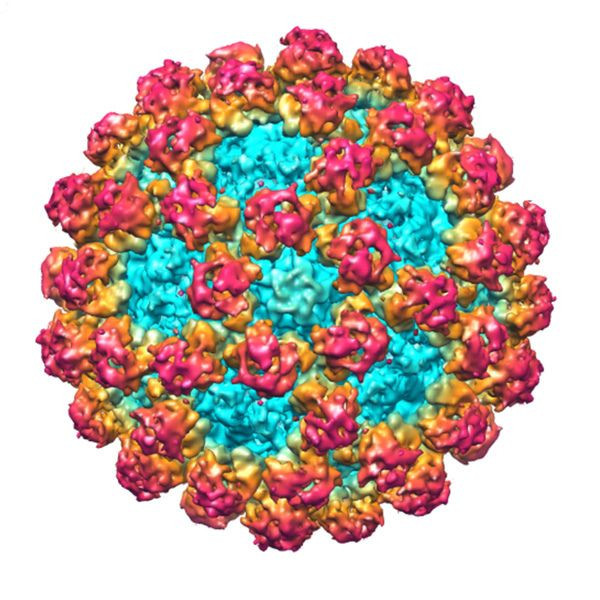Norovirus Facts, Symptoms And How To Avoid Being Infected By The Stomach Bug

This question originally appeared on Quora. Answer by Tirumalai Kamala.
Unfortunately, just sitting far enough away from someone who might have Norovirus isn't sufficient to stave off getting infected with it. This is not only because it's highly contagious but also because of
- How Norovirus spreads: Not just directly through fecal-oral transmission but also from eating and drinking contaminated food and water, handling contaminated surfaces and objects (fomites) followed by hand-to-mouth contact, and via ingestion of aerosolized particles (1), a Norovirus property unique among GI tract pathogens (2).
- For example, samples from mantels and light fittings 1.5 meters above the ground during a hotel outbreak in England were positive for Norovirus (3), suggesting source to be aerosolized particles released from vomit.
- How long Norovirus can stay infectious in the environment (4).
These two factors help explain why it can spread so fast in places where people spend time in close proximity to one another, such as on cruise ships, hospitals and nursing homes.
So far, only genetic fortune in the form of a single nucleotide mutation (G428A) in the FUT 2 gene (FUT2 - Wikipedia) on chromosome 19 provides strong protection against Norovirus (5, 6). This mutation is present in ~20% of whites.
According to the US CDC (7),
- Norovirus outbreaks 'can occur anywhere people gather or food is served'.
- Cruise ship outbreaks account for only ~1% of all reported Norovirus outbreaks with 70% caused by infected food workers.
Norovirus patients usually vomit and have diarrhea. Several reasons for why infected Norovirus patients are so contagious,
- While they shed billions of virions in their vomit and stool, 'it only takes as few as 18 viral particles to infect another person' (7, 8, 9, 10).
- People can spread Norovirus both even before feeling sick and as long as two weeks after starting to feel better (11).
- Norovirus on a variety of surfaces such as ceramic plates, drinking glasses, stainless steel forks is more resistant to traditional decontamination methods (12).
- Norovirus can remain infectious (13) on reusable grocery bags for as long as 2 weeks (14) and diaper changing stations (15).
Norovirus on ceramic plates, drinking glasses, stainless steel forks is more resistant to strong disinfectants compared to other microbes: One study (12) assessed capacity of restaurant-style cleaning procedures to eliminate Norovirus. In the US, as per the FDA Food Code (13), restaurants and other food service establishments are required to use disinfectant procedures that can reduce microbial load on tableware and food preparation utensils by a minimum of 5 logs.
The authors smeared ceramic plates, drinking glasses and stainless steel forks with mouse Norovirus (MNV-1)-containing cream cheese and reduced-fat milk. Solutions containing powerful disinfectants such as sodium hypochlorite (chlorine) or quaternary ammonium (QAC) (12) reduced Norovirus by a maximum of only 3 logs.
Norovirus on a reusable grocery bag can be infectious without person-to-person contact and is detectable on it even 2 weeks later: Environmental sleuthing (see below from 14) traced the source of a Norovirus outbreak in Oregon to a reusable grocery bag. In this case, 13 to 14 year old soccer players had all fallen ill less than 48 hours after they'd traveled together out of town for a week-end tournament. First to fall ill on Saturday night was a girl (the index case) who moved into the room of one of the parent chaperones but these two then went home early Sunday with no further contact with the other players. Yet, seven other players fell ill over the next 48 hours. How?
Interviews revealed most of the ones who got ill ate cookies at a Sunday lunch, cookies that in turn had been left behind in a reusable grocery bag in the empty hotel room of the first girl who fell ill. Turns out this girl had been very ill in the hotel bathroom and likely spread Norovirus aerosol that landed everywhere including the reusable grocery bag hanging in the room. Scientists found the bag positive for Norovirus even two weeks later. Thus, this was a case of Norovirus transmission without person-to-person contact.

Norovirus from improperly disinfected diaper-changing station can cause infections not only to those who came in direct contact with it but to others in the same workplace as well: In another Oregon outbreak (see below from 15), 12 of 16 auto-dealership employees fell ill after a staff meeting. In this case, the culprit wasn't among the take out sandwiches but rather an unwelcome 'gift' left behind by a customer whose toddler 'sprayed' the dealership's sole women's restroom with diarrhea a mere 15 minutes before the staff meeting lunch began.
'When staff at the auto dealership were interviewed, we learned of an incident that occurred approximately 15 minutes before the luncheon began. A female staff member (employee A) had entered the sole women's restroom at the dealership to discover a customer managing a toddler with diarrhea by holding the incontinent child over the trash receptacle while the toddler was (in the staff member’s words) “spraying.” The wall-mounted diaper changing station (brand X) was deployed and was visibly soiled with fecal material, as were the floor, walls, and trash can. The child’s mother left the mess for employee A, who attempted to clean up with dry paper towels. No gloves or disinfectants were used, but employee A reported subsequently washing her hands with soap and water.
Meanwhile, employee B had gone to pick up the food for the meeting. Immediately after cleaning the restroom, employee A opened the door for employee B when the latter returned with the food. Employee A was the first to take one of the un-wrapped sandwiches off the platter. Four of 5 female cases reported eating a sandwich, as did 6 of 7 male cases.
All 5 female employees working that day became ill; all reported use of the restroom after the diarrheal incident. Seven of 11 male employees (64%) became ill — not a statistically significantly different rate. None of the men entered the ladies’ rest-room.'

Thus in this case, after getting directly exposed to fecal material left behind on an improperly disinfected diaper-changing station by a sick toddler, female employees sufficiently contaminated their wider work environment, including uncovered sandwiches, to cause their male colleagues to fall sick as well.
Meanwhile, government policies increase, not decrease, chances of sick workers transmitting Norovirus.
- For example, '10 [US] states have passed laws prohibiting local governments from establishing sick-leave laws' (16).
- A US CDC survey of 491 restaurant workers in 2011 found a fifth (20%) worked while sick with vomiting or diarrhea (17).
- The US CDC has also found that sick line-cooks can spread Norovirus by coming to work sick (18).
Bibliography
1. Hall, Aron J., et al. "Updated norovirus outbreak management and disease prevention guidelines." MMWR Recomm Rep 60.3 (2011).
2. Hall, Aron J. "Noroviruses: the perfect human pathogens?." Journal of Infectious Diseases 205.11 (2012): 1622-1624.
3. Cheesbrough, J. S., et al. "Widespread environmental contamination with Norwalk-like viruses (NLV) detected in a prolonged hotel outbreak of gastroenteritis." Epidemiology and infection 125.01 (2000): 93-98.
4. Lopman, Ben, et al. "Environmental transmission of norovirus gastroenteritis." Current opinion in virology 2.1 (2012): 96-102.
5. Lindesmith, Lisa, et al. "Human susceptibility and resistance to Norwalk virus infection." Nature medicine 9.5 (2003): 548-553.
6. Rydell, Gustaf E., et al. "Susceptibility to winter vomiting disease: a sweet matter." Reviews in medical virology 21.6 (2011): 370-382.
7. Clinical Overview
8. Teunis, Peter FM, et al. "Norwalk virus: how infectious is it?." Journal of medical virology 80.8 (2008): 1468-1476.
9. Atmar, Robert L., et al. "Norwalk virus shedding after experimental human infection." Emerging infectious diseases 14.10 (2008): 1553.
10. Aoki, Y., et al. "Duration of norovirus excretion and the longitudinal course of viral load in norovirus-infected elderly patients." Journal of Hospital Infection 75.1 (2010): 42-46.
11. NBC News, Maggie Fox, January 28, 2013. Norovirus: Why washing your hands isn't enough
12. Feliciano, Lizanel, et al. "Efficacies of sodium hypochlorite and quaternary ammonium sanitizers for reduction of norovirus and selected bacteria during ware-washing operations." PLoS One 7.12 (2012): e50273.
14. Repp, Kimberly K., and William E. Keene. "A point-source norovirus outbreak caused by exposure to fomites." Journal of Infectious Diseases 205.11 (2012): 1639-1641.
15. Repp, Kimberly K., Trevor P. Hostetler, and William E. Keene. "A norovirus outbreak related to contaminated environmental surfaces." Journal of Infectious Diseases (2013): jit148.
16. The Atlantic, Olga Khazan, March 5, 2014. Poor and Hispanic Workers Are Least Likely to Have Sick Days
17. Restaurant Food Handling & Food Safety Practices
18. Norovirus Outbreak Associated with Ill Food-Service Workers --- Michigan, January--February 2006
Thanks for the R2A, Jonathan Brill.




















